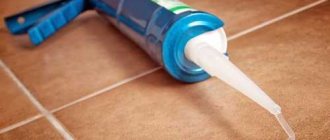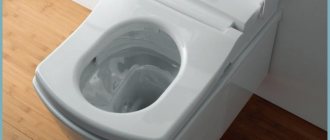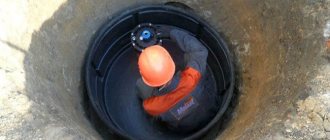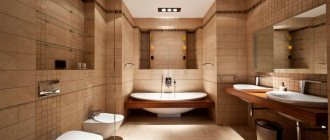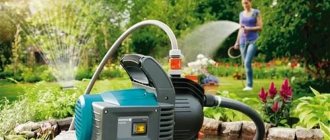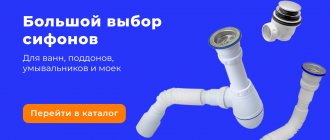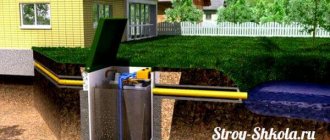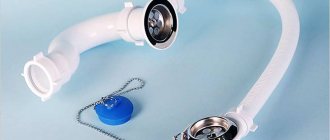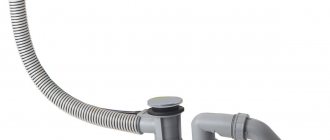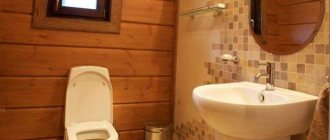Cities and towns, factories and farms, residential buildings and public buildings - everything is entangled in a network of water pipelines distributing cold and hot water throughout the buildings. But any system must be closed - otherwise all the buildings will simply flood. At the same time, water from the system must be available to people at any time - this is the main purpose of creating a pipeline system.
We welcome our dear reader and offer you an article about what ball valves for water supply are - shut-off valves that block or open the free flow of water in a pipeline. A characteristic feature of such fittings is the shape of the locking element - in the form of a ball or its segment.
Purpose
Pipeline systems cannot be open all the time they are in operation. Any water supply system must be shut off at least twice: at the point of use and at the point where water enters the building or apartment. A large plumbing system must have shut-off valves that allow you to shut off any of its parts individually. Reliable, convenient and durable ball valves are becoming increasingly widespread in all areas of human activity.
The scope of application of ball fittings is very extensive:
- In industry. Pipelines and shut-off ball valves are found everywhere - in hydraulic and pneumatic drive systems, fuel, gas, chemical reagents, and water supply pipelines.
- In the infrastructure of cities and towns - in main heating systems, water and gas supply.
- In everyday life - in any house and apartment there is a pipeline for supplying gas, hot and cold water, heating.
Popularity indicators for the use of water shut-off devices
The use of such fittings in everyday life is very common, but it is practically impossible to answer the question of which device (valve, valve, ball valve) is better. It depends on the system in which it is installed and the method of operation. Each device has its pros and cons. They must be taken into account when installing in a specific wiring diagram. One device may be a perfect fit, while others may not live up to expectations.
Before the advent of the ball valve, valves and valves were used in the water supply system.
Design and principle of operation
A ball valve consists of a body, a spherical-shaped shut-off element (plug), mounted on a rod (perpendicular to the axis of movement of the medium). The locking element has a round hole for the passage of the medium. The locking element (plug, valve) and seat are sealed with fluoroplastic or synthetic rubber. The rod (spindle) is turned by a handle.
To completely shut off the pipeline, it is enough to turn the handle that rotates the rod 90°. In this case, the ball-shaped valve rotates and its solid side reliably and hermetically blocks the flow of the medium. When the handle is opened, the valve rotates so that the axis of the through hole in the valve coincides with the axis of the pipeline and the liquid moves freely through the valve.
The design features of the ball valve make it possible to shut off the flow of the medium very easily and quickly, especially in comparison with gate valves and valves. Therefore, previously popular valves (valves), which had to be turned for a long time to shut off the flow, are becoming a thing of the past, and lever mixers are already installed in every apartment.
What is an entrance tap to an apartment?
Let me remind you that the internal water supply system of a house consists of: inputs to the building, water metering units, distribution water supply network, water supply risers, connections to plumbing fixtures and installations. As well as water supply, mixing, shut-off and control valves. Read: What is a collector water supply scheme.
As we can see from this regulatory definition, the inlet tap into the apartment belongs to the internal water supply system, namely its utility and drinking part.
Technically, the more correct name for an apartment's inlet tap is a shut-off valve that separates the water supply riser from the apartment's water supply.
It is this boundary location that gives rise to frequent disputes about who should repair it and at whose expense. I will not get involved in this dispute, I will only note that when putting a house into operation, only the installation of inlet shut-off valves is required. Read: Who should check and replace water supply risers
If during the operation of the house the residents do not make other decisions, the water supply riser valve is part of the common property of the apartment building.
Since residents pay for the maintenance and repair of housing, it is quite reasonable to assume that emergency repairs (replacement) of the inlet shut-off valve should be carried out by the building management company or HOA. The same applies to major repairs or planned repairs of the house’s water supply system, and with it the valves.
Read: How does a toilet work?
However, it seems to me that if a tenant decides to renovate the bathroom at his own request, replacing the inlet shut-off valve is carried out at his expense.
For example, you decide to replace the water supply risers within the boundaries of your apartment. It is illogical to replace risers at your own expense, and valves at the expense of the repair fund. Although there may be options.
What materials are they made from?
There are many materials for the manufacture of ball structures:
- Carbon steel. The most commonly used steels are 20 and 09G2S (this steel can be used at temperatures down to -60°C). Steel products are inexpensive, strong, durable, but susceptible to corrosion - they are coated with chromium or nickel to protect them.
- Stainless steel, most often grade 12Х18Н10Т. Stainless steel products can be used in systems with aggressive environments, at low temperatures, they are strong and durable, but quite expensive.
- Brass is an alloy of copper and zinc. Brass is strong and ductile, does not rust, is durable, but loses strength already at 200°C. But in residential buildings such temperatures do not exist, and at the moment this is the most popular material for small-diameter taps in housing.
- Bronze is an alloy of copper and tin (varieties of bronze are alloys with aluminum, silicon, beryllium, lead). The quality of the products is similar to brass, the price is higher. They don't occur very often.
- Titanium. Lightweight, durable, expensive, not used in everyday life.
- Plastic. They are used for plastic pipelines, made of the same material (some are made of unplasticized PVC, polyethylene, polypropylene). Such taps have sufficient strength, are not prone to corrosion, and are chemically inert. Less reliable than metal products. In everyday life, they are used on water supply and heating systems, but not at the entrance to an apartment or house.
- Ceramics. New strong, durable material. Durable, non-corrosive, chemically inert. They are quite expensive and, despite their strength and wear resistance, they are fragile and resistant to shocks and falls.
- Cast iron. Archaism. Found in some old plumbing systems (not in households).
- Silumin. Aluminum alloy with silicon. In practice, we can assume that silumin fittings are fake. They don’t last long, they crack, the threads are cut off, and they start leaking at the most inopportune moment. In general - transfer of money.
How to choose an inlet tap for an apartment
I will definitely devote a separate article to this issue, briefly here. Understanding the importance of the purpose of inlet taps, for the correct choice there should be only one criterion - reliability.
Therefore, exclude valves made of zinc-aluminum alloy (TSAM or ZAMAK) from your choice. It is often called silumin, but this is not true, although silumin is even worse than TsAM.
Give preference to stamped brass valves with ball lock (ball valves). Don't buy valves. They are cheaper, but wear out faster. The water from the riser has not yet been cleaned by mud collectors, so the valve valve quickly wears out, although it can be repaired.
Classification - types and differences
Depending on the method of connection to the system, ball valves are:
- Welded - they are welded to the pipeline and used in critical systems with high pressure.
- Flanged.
- Fittings - with external thread.
- Couplings - with internal thread.
- Combined - connected to the system from different sides in different ways.
According to the throughput capacity, cranes are:
- Full bore - the diameter of the passage in the plug is equal to the diameter of the pipeline.
- Standard bore (reduced) - the size of the hole in the ball is one standard size smaller than the diameter of the pipeline.
Structurally - there are straight and angular designs, two-way and three-way.
According to the locking mechanism
- With a floating ball. The floating ball is not rigidly connected to the handle rod and can be pressed against the sealing ring, improving the sealing of the closed tap.
- With a ball in supports. In the design with a ball in supports, the ball is installed and rotated in the supports; in the lower part it has an axial protrusion that fits into a recess in the body. The surface of the ball is pressed tightly against the seats and, when closed, the structure is reliably sealed.
Which tap is better to use for water supply as the main one at the entrance to the apartment?
No matter what material the pipeline in a house or apartment is made of, metal shut-off valves are always installed at the input. Metal structures are more reliable, and if they fail, they are easier and faster to replace.
Which type is better for plumbing?
It is impossible to say unequivocally which types are better. Steel products can rust and become overgrown with salts; Unusual titanium, ceramic, and stainless steel are rare, they are expensive and there is no particular point in installing them. What remains is brass (bronze) and plastic. The input is definitely brass; parts of the system made of plastic can also be made of polypropylene. If the system is mounted from cross-linked polyethylene, then the pipes are mounted using fittings, and it is most convenient to attach metal products to them.
Crane classification
Ball valves are used in industry and everyday life. During this time, consumers appreciated the pros and cons of this equipment. They are installed on pipes of different diameters.
Before considering the variety of such shut-off valves, it is worth considering how a faucet differs from a mixer. What are these pipeline structural elements?
- Tap. A universal device that can act as both an intermediate element of the pipeline and its end point. In the latter case, he performs the work of the mixer.
- Mixer. As for this product, it is used to mix water and regulate its temperature. In this case, the tap only affects the pressure force.
Each type of fittings has its own design and functional features that should be taken into account when choosing them. Particular attention should be paid to the types of products.
Marking
The following is applied to the body:
- Manufacturer's emblem.
- Nominal diameter - DN - in mm and inches, but for small bodies the "inch" symbol may be omitted.
- PN - working pressure in bars. A bar is equal to 1 atmosphere and 0.1 MPa.
Material of manufacture
As for the material, you should pay attention to the two most commonly used options:
Brass
High resistance to mechanical stress. Withstands any careless handling and survives the most extreme situations.
- High resistance to temperature changes
. Calmly withstands the pressure of hot water and does not deteriorate in the cold. - Ease of installation
. easy to install and dismantle. - No corrosion processes
. Most other metals cannot boast of this property.
Plastic
Polypropylene is a relatively new material, which, despite this, has already managed to take a strong position in the plumbing industry.
Plastic taps boast the following advantages:
- Low cost. Plastic products are always cheap, especially when compared with their metal counterparts.
- Low weight. Due to this, there is no pressure on the pipeline.
- Reliability of joints. The plastic pipeline is installed using a special soldering iron, which guarantees complete tightness. Although it should be taken into account that there are also classic models with threaded connections.
- Neutrality to the aquatic environment - does not rust and does not change the taste of water.
- Durability. Polypropylene decomposes no earlier than after 200 years.
But there are also some difficulties that you need to be aware of when choosing shut-off valves from this material:
- Weak resistance to mechanical stress. The plastic may crack under severe physical stress.
- Fear of high temperatures. Polypropylene begins to deform already at +95 degrees Celsius.
Therefore, depending on the conditions in which your water supply system will serve, choose which material is more suitable.
Advantages and disadvantages of ball valves
Advantages of ball valves:
- Compact dimensions.
- Simple reliable design.
- High tightness.
- Rapid shut-off of the medium flow.
- Management does not require much physical effort.
- Low hydraulic resistance, comparable to the resistance of a straight section of pipe.
- Small price.
- Metal taps can be used in high pressure systems.
- Can be used for viscous and contaminated media.
- High-quality seals provide cranes with a long operating life without repairs or maintenance.
Flaws:
- The use of fluoroplastics limits the operating temperature to 200°C.
- Plastic products cannot be used at high pressures.
Which taps are best installed on cold water and hot water risers?
Previously, in our article it was already described which valve is better, ball or valve. With the help of the latter, you can not only block, but also regulate the direction of energy flow on the risers. Naturally, it is better to install reliable taps on residential hot water and hot water risers! It’s better to spend money on quality devices than to make repairs for yourself and your neighbors.
|
Tips for choosing
Almost the entire choice of the best ball valves for the home comes down to brass products - reliable, non-corrosive, durable, inexpensive and widespread. On polypropylene pipes, polypropylene structures are used to disconnect part of the system. Metal products are always placed at the input.
Leaking water systems are expensive, so you should buy products in fairly large stores, with a receipt and certificate. Do not focus on imported products - domestic manufacturers also produce good quality products.
The tap must be inspected - there should be no chips or cracks; the thread must have at least 4-6 full turns without nicks; the walls must be thick enough; it is necessary to inspect the inside of the faucet, check how the handle and the ball turn, whether there is a hole in the ball (and whether there is a ball - occasionally there are “dummies” in which the body is machined like a pipe, the handle does not turn, there is no ball in sight). In addition, you need to try to understand whether the body is silumin - the metal inside will be white, and the faucet will seem light - the density of silumin is less than that of brass (according to the standard - 8.5-8.7 g/cm³). You can’t buy silumin - sometimes it bursts during installation.
The handle is more reliable and practical than the butterfly handle, but when installing the faucet against a wall or in a cramped bathroom, you should consider whether there is enough space to turn the lever, or whether you should buy a butterfly handle. For the entrance, a faucet with threaded pipes of the “nut-fitting” type is most often chosen.
approximate price
Brass taps with running diameters of 15 and 20 mm cost from 150 rubles, polypropylene taps of the same diameters - from 110 rubles. A lever faucet for a kitchen will cost from 2,000 rubles (the simplest) to... there is no limit to perfection - there are faucets that cost tens of thousands, and for a shower they can reach up to 100,000.
Plastic or metal faucet
With the arrival of polypropylene pipes on the market, polypropylene taps began to be actively promoted. They are offered as a cheap alternative to brass. Any plastic under constant temperature influence can become unusable in a short time. This is important to consider when purchasing plastic taps.
Often, polypropylene taps are connected to a pipe by welding. After the faucet fails, you will need to cut off the pipe and weld a new faucet into it. With metal taps everything is different. You need to unscrew one and install the other.
When choosing the best faucet, remember that a brass faucet is always more reliable than any plastic.
Tips for installation and operation
Before installing the tap, wipe the threads with a rag and clean them from dust, shavings, and dirt; the old thread should be driven out with a die - this will clean the thread from rust and deposited calcium and magnesium salts. First, the faucet is tried on - screwed on without FUM tape and the number of turns is remembered. The direction of winding the tape must coincide with the direction of winding the reinforcement. Screw the tap on the same number of turns as during fitting. The minimum number of turns is 4. Then the bend is screwed in in the same way or the nut is screwed on the other side.
The system is filled with water and tested; if there is a leak, the connection will have to be unscrewed, a sealant (FUM) added, tightened and tested again.
During operation, it is necessary to close and open the tap at least once a month - this will remove salt deposits from the ball. The shutter cannot be kept partially open - this will lead to premature wear of the shutter. The handle position must be either open or closed.
Locking elements
First of all, let's look at what types of water taps there can be according to the structural features and functioning of their locking elements:
Conical
Closing and opening the passage in such a tap is carried out by raising and lowering the cone-shaped plug.
At one time, this design was very widespread, but today it is practically not used due to very significant disadvantages:
- Labor-intensive to use with your own hands
. In order to open or close such a device, a large torque is required, even taking into account the small cross-section. - Rapid wear
. The conical plug, which is responsible for the efficiency of the product, too quickly loses the accuracy of its fit to the walls of the body, which makes the faucet unsuitable for further use. - The price is quite high
due to the complexity of processing the cone of the locking part, where the slightest mistake will lead to a lack of the necessary tightness.
Cylindrical
In this case, the locking function is carried out by moving the cylinder, which provides the following differences from the previous version:
- The manufacturing technology has been simplified, which reduces the cost of the finished product.
- There is no complete seal.
Ball
Here the principle of operation is fundamentally different from previous variations of water taps. The locking element is a steel ball with a through hole in the middle.
By turning the handle connected to the ball by a rod, we thereby change its position:
- The hole is turned towards the wall of the valve body, and the passage is completely blocked.
- The hole is turned towards the inlet pipe, as a result of which the passage is free for fluid movement.
This device provides the ball valve with the following advantages, thanks to which it is today the leader in the market of sanitary shut-off valves:
- Affordable cost
, which is ensured by ease of manufacture. - Basic operating instructions
. It is enough to slightly turn the handle 90 degrees to change the state from “open” to “closed” and vice versa.
- Low weight
, due to which there is practically no load on the pipeline. - Reliability and wear resistance
. There is no such fast production as in previous models. - External attractiveness
. The small size of the faucet itself makes it almost invisible, and the protruding handle in the form of a lever or butterfly looks quite aesthetically pleasing.
Thus, if we talk about the bolt mechanism, then ball models definitely win.
Ball valves or valves, which is better?
When choosing shut-off valves, the following must be considered. A polypropylene faucet can operate without interruption for several decades. According to the statements made by the manufacturers of these products, they can last up to 50 years. Cone valves differ from them in that scale is concentrated on the surface, and you can be sure that this scale will sooner or later become an insurmountable obstacle when closing or opening the valve. In addition, it is impossible to compare the overall dimensions of ball and cone products. And yet, cone valves require regular inspection.
Polypropylene ball valves do not suffer from such disadvantages. In addition to their low weight and high reliability, they look much nicer than other models of shut-off valves. For the production of ball valves, the following materials are used:
- steel;
- cast iron;
- polyethylene;
Taking into account all of the above, we can draw a simple conclusion - spherical products exceed conical ones in all respects.

